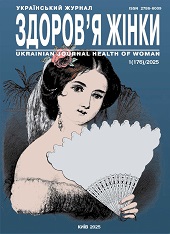Endometrial pathology in postmenopausal women
DOI:
https://doi.org/10.15574/HW.2025.1(176).5458Keywords:
postmenopause, gynecological pathology, menopausal hormone therapy, postmenopausal bleeding, endometrial hyperplasia, endometrial polypsAbstract
Vaginal bleeding is the most frequent clinical manifestation of intrauterine pathologies, they are observed in 12% of postmenopausal women and are the main reason for consulting a gynecologist.
Aim - to study the prevalence of gynecological pathology in postmenopausal women and to assess the impact of menopausal hormone therapy (MHT) in the anamnesis on the frequency of its occurrence.
Materials and methods. A retrospective analysis of medical records of 82 postmenopausal patients was conducted, who were divided into two groups: those who received MHT during the menopausal transition (MHT+; n=41), and those who did not receive it (MHT-; n=41). Gynecological complaints, transvaginal ultrasound (TVUS) results, and histological findings from pipet biopsy or hysteroscopy were assessed. Statistical analysis was performed using the chi-square test.
Results. 55 (67,0%) patients had gynecological symptoms such as spotting or bleeding in postmenopause, postcoital bleeding, cramping pain in the lower abdomen, discomfort during intercourse, abnormal discharge, and vaginal dryness. According to TVUS, endometrial thickness of more than 5 mm was detected in 23 patients, and in 4 patients, additionally, multiple blood flow loci and endometrial heterogeneity were detected. According to the results of histological examination, atrophic endometrium and endometrial hyperplasia without atypia were most often detected in the both groups, and less often, endometrial polyps and atypical endometrial hyperplasia.
Conclusions. The most common ultrasound manifestation of endometrial pathology was endometrial hyperplasia, which was detected in 13 (31.7%) women in the MHT+ group and in 10 (24.4%) women in the MHT- group. The most frequent histological findings were atrophic endometrium (34.14% and 39.02%, respectively, in the MHT+ and MHT- groups) and endometrial hyperplasia without atypia (26.82% and 19.51%, respectively, in the MHT+ and MHT- groups), regardless of the history of MHT.
These results indicate the absence of the effect of menopausal hormone therapy on ultrasound and histological changes of the endometrium in postmenopause.
The research was carried out in accordance with the principles of the Helsinki Declaration. The study protocol was approved by the Local Ethics Committee of participating institution. The informed consent of the patient was obtained for conducting the studies.
No conflict of interest was declared by the authors.
References
ACOG. (2012). Committee Opinion no. 534: Well-woman visit. Obstet Gynecol. 120: 421-424. https://doi.org/10.1097/AOG.0b013e3182680517; PMid:22825111
Carugno J. (2020, Aug). Clinical management of vaginal bleeding in postmenopausal women. Climacteric. 23(4): 343-349. https://doi.org/10.1080/13697137.2020.1739642; PMid:32233689
Clarke MA, Long BJ, Del Mar Morillo A, Arbyn M, Bakkum-Gamez JN, Wentzensen N. (2018, Sep 01). Association of Endometrial Cancer Risk With Postmenopausal Bleeding in Women: A Systematic Review and Meta-analysis. JAMA Intern Med. 178(9): 1210-1222. https://doi.org/10.1001/jamainternmed.2018.2820; PMid:30083701 PMCid:PMC6142981
Jo HC, Baek JC, Park JE, Park JK, Cho IA et al. (2018, Dec). Clinicopathologic Characteristics and Causes of Postmenopausal Bleeding in Older Patients. Ann Geriatr Med Res. 22(4): 189-193. https://doi.org/10.4235/agmr.18.0042; PMid:32743272 PMCid:PMC7387628
Nijkang NP, Anderson L, Markham R, Manconi F. (2019). Endometrial polyps: Pathogenesis, sequelae and treatment. SAGE Open Med. 7: 2050312119848247. https://doi.org/10.1177/2050312119848247; PMid:31105939 PMCid:PMC6501471
Oguz S, Sargin A, Kelekci S et al. (2005). The role of hormone replacement therapy in endometrial polyp formation. Maturitas. 50(3): 231-236. https://doi.org/10.1016/j.maturitas.2004.06.002; PMid:15734604
Ring KL, Mills AM, Modesitt SC. (2022, Dec 01). Endometrial Hyperplasia. Obstet Gynecol. 140(6): 1061-1075. https://doi.org/10.1097/AOG.0000000000004989; PMid:36357974
Swain M, Kulkarni AD. (2021, Oct-Dec). Endometrium at Menopause: The Pathologist's View. J Midlife Health. 12(4): 310-315. https://doi.org/10.4103/jmh.jmh_218_21; PMid:35264839 PMCid:PMC8849152
Ulin M, Ali M, Chaudhry ZT, Al-Hendy A, Yang Q. (2020, Feb). Uterine fibroids in menopause and perimenopause. Menopause. 27(2): 238-242. https://doi.org/10.1097/GME.0000000000001438; PMid:31834160 PMCid:PMC6994343
Vitale SG, Capriglione S, Zito G et al. (2019). Management of endometrial, ovarian and cervical cancer in the elderly: current approach to a challenging condition. Arch Gynecol Obstet. 299: 299-315. https://doi.org/10.1007/s00404-018-5006-z; PMid:30542793
Downloads
Published
Issue
Section
License
Copyright (c) 2025 Ukrainian Journal Health of Woman

This work is licensed under a Creative Commons Attribution-NonCommercial 4.0 International License.
The policy of the Journal UKRAINIAN JOURNAL «HEALTH OF WOMAN» is compatible with the vast majority of funders' of open access and self-archiving policies. The journal provides immediate open access route being convinced that everyone – not only scientists - can benefit from research results, and publishes articles exclusively under open access distribution, with a Creative Commons Attribution-Noncommercial 4.0 international license (СС BY-NC).
Authors transfer the copyright to the Journal UKRAINIAN JOURNAL «HEALTH OF WOMAN» when the manuscript is accepted for publication. Authors declare that this manuscript has not been published nor is under simultaneous consideration for publication elsewhere. After publication, the articles become freely available on-line to the public.
Readers have the right to use, distribute, and reproduce articles in any medium, provided the articles and the journal are properly cited.
The use of published materials for commercial purposes is strongly prohibited.

